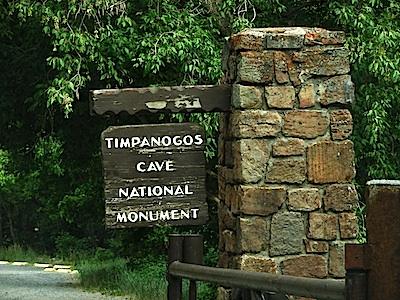
A long overdue return to Timpanogos Cave/Lee Dalton
Editor's note: User fees are becoming more and more prevalent on public lands used for recreation. Are they worth it? Contributor Lee Dalton, a long-time National Park Service seasonal and educator, muses on that matter after visiting Timpanogos Cave National Monument in central Utah.
The other week I drove down to Utah's American Fork Canyon and Timpanogos Cave National Monument. It's been nearly 30 years since I last visited Timpanogos, so this time I came to spend a few days and hike the mile-and-a-half climb up a thousand feet of sheer cliff to tour the cave. But as someone once wrote, 'E'en the best laid plans o' mice n' men are gang aft agley.' (You have to enjoy bagpipe music to translate that.) A nasty sore throat turned into an even nastier chest cold and a trip to Urgent Care, where the nice doctor dosed me up with some curative stuff. Trouble is, it didn't kick in immediately so I stayed in camp, barking and snuffling and feeling sorry for myself as the appointed time for my cave tour came and went. I figured that if I was having trouble breathing it might not be a good idea to go chuffing up that steep trail to the cave.
During my visit, I discovered that a few things have changed since the last time I was here. What was a rather rustic canyon with a dirt road once you passed the cave, is now a paved road all the way. In fact, it's a four-lane highway right up to the canyon mouth. It's not a quietly bucolic canyon any more. Scenic Alpine Loop Road is a narrow, winding, steep drop-offs no guard-rail mountain road that forces a driver to choose between looking at some incredible alpine scenery or keeping his vehicle on the road. On weekends, it's a procession of traffic of all kinds. It's also a place where an occasional invincible young testosterone crazed buck decides to test his manhood and ignore the double yellow line to roar down or uphill as fast as his jacked up truck or bullet bike will go. Happily, they are in the minority and in between them are loads of families enjoying time in a once wild place that is now a cross between a wilderness and a city park.
Except for the very small chunk of land belonging to the National Park Service at Timpanogos Cave, the rest of this country is part of Uinta National Forest. Signs along the way remind us frequently that Your fees paid for these improvements. Some Traveler readers who chafe at user fees would be driven to complete madness here. There is an entrance station at the mouth of American Fork Canyon where young women in U.S. Forest Service uniforms were joined by one wearing the green and gray with an arrowhead sleeve patch. I thought it was a wondrous sight to behold. USFS and NPS coexisting in peace as they tried frantically to collect all the dollars from outstretched hands and check all the passes to speed passage of a very long line of vehicles. It's Sunday afternoon and the stories of busy weekends must be true.
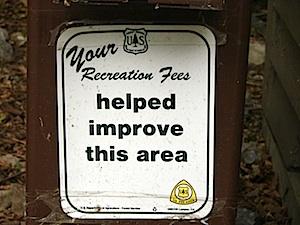
U.S. Forest Service fees help maintain the national forest surrounding the national monument/Lee Dalton
The first fee collected is your entry fee that will allow you to drive as far and do almost anything you wish on the Alpine Scenic Loop. When I reach the kiosk I'm handed a small hanger into which I must insert my Golden Geezer pass and dangle it from my mirror. Entry for me is free, but for normal people it's $6 per carload. Driving on up the very narrow canyon, I pass through the national monument's parking lot, past the visitor center and on to Little Mill campground on the Uinta forest where I have a reserved campsite waiting courtesy of Recreation.gov. For younger folks the campsite would be $21 per night. Unlike the NPS, the Forest Service does not cover the reservation fee charged by Rec Dot Gov and I find an extra $9 tacked onto my bill. But before I made my reservation I was able to look at a photo of my site and learn things like how much shade it has before I sent them my Visa number.
If I just wanted to picnic at one of the many picnic areas in the canyon, I'd have to fork out another eight bucks ' per car. Fourteen dollars or more just to have a picnic? Apparently, though, there has been enough belly-aching that the Forest Service has backed off a bit. Starting this year, anyone who claims to be entering the area just to camp at one of the established campgrounds is not charged the entry fee. That must be very interesting to enforce.
I can hear the anguished wails of anti-fee friends. So I ask: Is it worth it? Is it fair?
Little Mill is just a couple of miles up canyon from Timpanogos. All its campsites are strung along the south bank of the American Fork River. Just on the other side of the river is the scenic loop road. On Sunday, camping in Little Mill is like camping on the shoulder of I-15. Fortunately, the river makes a lot of white noise and pretty well obliterates the sounds of all but the loudest vehicles. Every campsite is paved and contains a large concrete pad with a picnic table, fireplace, and charcoal grill. The entire campground is wheelchair accessible.
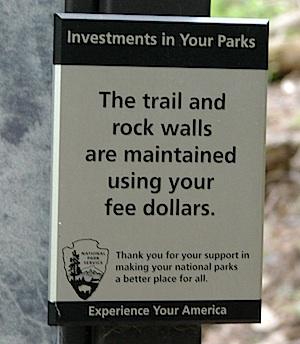
Fees collected at Timpanogos Cave also help maintain the monument/Lee Dalton
The campground is operated, as are most other USFS camps in northern Utah, by a concessionaire ' American Land and Leisure. Instead of volunteer campground hosts, AL&L's hosts are paid. But instead of simply collecting fees and answering questions as NPS volunteers are supposed to do, these folks actually maintain the campground. I have to say that almost everywhere I've camped in an AL&L campground, they are doing a fine job of it. Little Mill is immaculate. The pit toilets are clean and actually smell good. Fire pits have been cleaned out and every picnic table I've looked at has been washed recently. The main gate is locked at ten every evening. Keeps the party crowd out.
It's Monday evening now, and after a quiet day of little traffic on the road, it's back to almost yesterday's volume. Probably local people heading up and down as they enjoy a beautiful weekday evening in the mountains.
A Forest Service pamphlet tells me that in the area around American Fork Canyon, there are 22 roads open to pedestrians and vehicles of various kinds. All are open to equestrian use and all are open to bicycles. Eighteen are open to ATVs and 21 may be used by four-wheel drive vehicles. In addition to the roads, there are 30 trails designated on the map. The total roads and trails open to off-road motorcycles number 45. There are 25 hiking trails that also accommodate trail bikes. All but one of the 30 hiking trails are also open to horses. I can't tell from the accompanying map how many miles of roads and trails we're talking about, but it has to be a big number.
So, is it worth it?
Looking around me and understanding a little of the tremendous population explosion in this part of Utah, I have to say that it is. Given the extremely heavy use of the entire area by all sorts of recreational pursuits from hiking to cross country skiing, mountain biking, rock climbing and horseback trails, from kayaking to off-roading, fly fishing and picnicking and camping and everything in between, I can only imagine what it must require to keep this the kind of place anyone would want to visit.
American Fork's canyon is literally in the backyard of several large and rapidly growing cities. Like so many other areas of public lands in places like Denver and Boulder Colorado or Los Angeles or San Francisco or even Cleveland in Ohio, our public lands are national playgrounds faced with meeting not only increasingly heavy use, but increasingly loud demands for every kind of recreational or thrill-seeking activity imaginable.
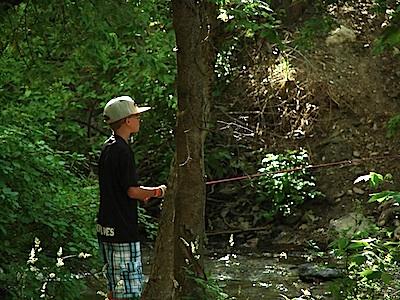
The American Fork River draws anglers young and old into the mountains/Lee Dalton
I meet Rick and Sandy Lees, the AL&L hosts at Little Mill. They are from just down the road in the town of Lehi, one of the many cities that use these mountains as their own playgrounds. Sandy tells me that she has just finished a seven-page incident report with photos. Seems a Utah family had a 15-year-old son with a hatchet. Despite warnings and a visit by a Forest Service law enforcement ranger, the kid's final tally was 17 trees chopped down or severely damaged. That, in addition to a visit from a Utah County deputy sheriff regarding use of what turned out to be an air rifle in the campground. She has no way of knowing whether or not any further action will be taken. And that's not the only story she has to tell.
I also think of the political tussling and compromises and cooperation that has to happen to make something like this possible. The forest and cave, of course, are under federal jurisdiction. Highway 92 is a state highway and designated Scenic Byway maintained by the Utah Department of Transportation. Campgrounds and picnic areas are concession-operated. Even the Park Service around here seems to have forgiven the tree guys for stealing our noble hat and putting it on their bear. I'm certain most people visiting these lands are completely unaware of what must be required to keep it all going.
In Utah, we hear loud and often angry demands that we need to 'take back' all those federal lands within the state. But what, I wonder, would happen if we did? Where would all the money come from to keep all this in its present condition? Would it be possible without literally taxing every resident of Utah into bankruptcy? Would it all need to be sold for extraction of resources or endless housing developments?
Even though ours is one of the fastest-growing state populations in the country, I can't imagine any way that Utah could handle it without the support provided by other taxpayers all across the nation.
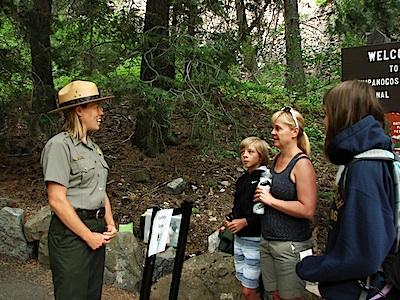
Mandatory safety talks prepare visitors for the long hike to the cave/Lee Dalton
And that brings us back to that question, is it worth it? When I hear fellow Utahns complaining as they often do about those 'extra' fees they must pay to use their public lands, I have to ask what alternatives are there? Is it really necessary to pave all the campsites in all the campgrounds along the Alpine Loop? Maybe not. But if they were not paved, how long could their roads and sites stand up to the constant heavy use they receive? How long would it be before they became hopeless mudbogs of eroded and rutted roads and trails or choking dust when it's dry?
And is it fair to expect a family from an Illinois city or a farmer in Wisconsin who is trapped by cows that must be milked twice a day every day to pay all of it for me? To pay for my campground and the trails I will enjoy on foot or riding my horse or ATV or mountain bike even though they can probably never share these places with me?
If those who wave yellow flags with rattlesnakes and yowl about taxation prevail, then who will clean these restrooms and campsites? Who will maintain the roads? Who will clear winter deadfalls from trails? Who will rebuild trails washed away by spring runoff? Who will fight the fires? Who will try to protect the lands and all they contain from families whose kids have hatchets?
To those who complain, I can only try to point out how lucky they are that fees are not even higher. Here in the West, our recreation ' indeed, operation of our entire state ' is being heavily subsidized by those Easterners our politicians and a few others love to demean as they push for 'retaking our lands.' Were it not for those federal dollars pouring into Utah and other Western states, those of us who enjoy these places we live in would be in a world of hurt. It would be a real hoot if Eastern taxpayers suddenly decided to 'take back' all the money they send out west.
Unfortunately, Utah voters are easily fooled by campaign promises and inflammatory rhetoric from those few who might profit. Similar stories are heard elsewhere whether it's the Great Smokies where backcountry campers are complaining about a few dollars or along some public beaches in California where fees are being charged.
For my part, I'll gladly pay a few dollars here and there if it means I'll have these kinds of places to enjoy. I hope that if we care for them now and tomorrow they will still be here when my grandkids bring their grandchildren to camp. A family's week here still costs less than a trip to the local movie house.
Is it fair? Is it worth it?
Tomorrow: Who gets those fees?



Comments
Lee what have I ever done to you to cause you to wish that horrible fate on me? :-)
Those of us who go back to the early days of Fee Demo (under Gore's "reinventing government" initiative) remember being solemnly promised that fees would never ever - ever - be used to offset appropriations, only to supplement them. Yeah, that and the tooth fairy. As was clearly foreseen at the time by many people, fees immediately began replacing appropriated funding for basic operations like cleaning toilets and emptying trash, while appropriated funding was diverted elsewhere to who knows where. Now all the agencies say that they are dependent on fees for their very existence. The concept of public lands, under shared ownership, being places where every American has access and is welcome, has been lost and nature is just another market commodity, competing for dollars with going to the movies, buying a latte, and theme park vacations.Those who make such comparisons are missing the point.
This pay-to-play approach has continued, and worsened, through all sorts of political changes and in both good and bad economies. Don't blame any particular party or political movement. Plenty of blame to go around.
KBenzar, I am in complete agreement with your post, thank you.
And I think I agree with her, too.
Now the BIG question -- what can anyone DO about it?
It's a much, much bigger question throughout the nation and not just in the area of public lands. It exists at Federal, state, county, and city levels.
We want services. We demand services.
But pay for them?
Don't tread on ME! Tread on somebody else!
Editor's note: The following comment is from Kitty Benzar.
“We want services. We demand services.”
That's simply not true of everyone. When I visit public lands I want to be left alone and get as far away from "services" and other people as I can. Nothing ruins my visit more than becoming another "visitor contact" for a ranger or concessionaire employee to log on their clipboard. Those who want services - developed campgrounds, picnic grounds, interpretive centers, guided outings, cabin rentals etc - should indeed have to pay extra for those, and FLREA allows the agencies to charge those kind of fees. Those have never been the issue.
The conflicts and controversy arise when people who only want to be able to take a stroll through the forest, sit watching a stream flow by, or watch the sunset over a lake are required to pay a fee to have those experiences.
Congress used to have a commitment to giving the public that kind of general access to undeveloped, dispersed recreation (at least on National Forests and BLM lands) in return for our tax dollars. Whether they still have that commitment or not is an open question.
FLREA prohibited fees for the kind of undeveloped recreation I describe, but the Forest Service and BLM have spent the last 10 years seeking ways to ignore or evade those prohibitions. Why? Because surprise, surprise, undeveloped recreation - by people who are NOT demanding services - is pretty popular. Since FLREA allows them to retain recreation fees without going through Congress and the Treasury, there is a huge incentive to try and leverage access to undeveloped areas (which they control) into a direct revenue stream (for which there is little accountability). The idea of citizen-owners is lost in the process and we become nothing more than customers.
Legislation to replace FLREA is being drafted in smoky back rooms by people with insider access as I write this. Will Congress re-commit to a robust system of public lands? Or sell them off, one nickel and dime at a time, to the forces of privatization? Will they write a stronger law that can't be twisted to mean the opposite of what it says, or one that legalizes the currently-illegal implementations? Word just in today that, whatever they're writing, the language will be posted on Monday July 14 and considered in the full House Natural Resources Committee two days later, July 16. No public input is scheduled.
As to the question What To Do? as always the answer is: contact Congress; contact Congress; contact Congress. It may not be sexy but unless you do it they think nobody cares.
Exactly! At CHNSRA they have started with $120 ORV permits. This was free until 2 years ago.
"The conflicts and controversy arise when people who only want to be able to take a stroll through the forest, sit watching a stream flow by, or watch the sunset over a lake are required to pay a fee to have those experiences." Kurt
I think the problem comes with people believing this doesn't have any cost. There are roads that get one there, parking lots for one's cars, maintained trails to allow one to wander there, fire and rescue services that keep one safe there, rangers to keep out the poachers and squatters and neer-do-wells... and the list goes on.
And there is a system in place to fund those services and it is called taxes. I don't agree that the NPS is underfunded as many shout, especially when they got such a huge influx from stimulus monies recently and other federal agencies are reducing budgets.
Now let's talk about responsible use of those funds in the NPS. Benzar is spot on. These things are decided in smoky back rooms. Why was Sally Jewell from REI placed at the helm? I'm sure it had nothing to do with the fact that she ran a company that provides concession services. Doesn't that say a ton about where the NPS priority is? Isn't that why Jarvis own brother is a concessionaire lobbyist? FLREA is garbage that allows the NPS to rape, murder and lie at their discretion with no oversight or incorporation of public input. It would jeopardize those who wish to profit from the NPS. Does the NPS exist for the concession crowd or the taxpaying public? In the Smokies they created a backcountry crisis to be solved by a miraculous software reservation system. When they received approval to charge fees and use recreation.gov, they decided they could pocket more money by eliminating rec.gov and did just that with no authorization whatsoever. Just like that they instituted a quarter million dollars per year in pure revenue. Simply by creating crises and formulating solutions.
Under FLREA it gives the federal land mgrs that kind of license. Its time to take the car keys away and ground these fee drunken teenagers. Im sure they could use more money. So could I.
John, the stimulus money went to mostly two infrastructure improvements. I don't know if you've bothered to go up 441 lately, but they have done substantial road work along that road, they have vastly improved the drainage (go look at the new stone work and drainage pipes on the side of the roadway next to places like LeConte and down from the Chimeys), and they have reinforced the road on the Tennessee side by driving in large steel beams that aren't cheap to keep the road from falling off the side of the cliffs near NFG. It was actually considerable the work that they did, and it has gone on for about 2 years. Also, the foothills parkway was funded with that stimulus money, and that new road will be done by 2016.
http://www.wate.com/story/10361395/great-smokies-to-receive-64m-in-stimu...
This work has occurred because of that stimulus money. And considering the Smokies doesn't have a fee, like most national parks, tax dollars are what paid for it.
So, the "smoky backrooms where they murder, lie and rape" actually seem quite visible to the public if you bother to open the blind old owls eyes and take a flight around the Smokies and see the work that has occurred over the last two years. I know i've sat in a lot of lines over the past two years while they did road work in the park. The foothhills parkway finally had funding to build the missing link bridge that is considered an engineering marvel.